Mostrar el registro sencillo del ítem
Valores de <F> Como Criterio Adicional de Selección Para Identificar Probadores Adecuados en Maíz
| dc.contributor.author | De León Castillo, Humberto | |
| dc.contributor.other | Sámano Garduño, Daniel | |
| dc.contributor.other | De la Rosa Loera, Alfredo | |
| dc.date.accessioned | 2019-08-23T14:38:43Z | |
| dc.date.available | 2019-08-23T14:38:43Z | |
| dc.date.issued | 2006 | |
| dc.identifier.uri | http://repositorio.uaaan.mx:8080/xmlui/handle/123456789/46009 | |
| dc.description | En el programa de mejoramiento del Instituto Mexicano del Maíz “Dr. Mario E. Castro Gil” de la Universidad Autónoma Agraria Antonio Narro se cuenta con un germoplasma de sobresaliente comportamiento agronómico tanto de manera per se como en combinaciones híbridas, con amplia plasticidad de adaptación y se distingue del resto del germoplasma porque todas sus plantas portan el gen braquítico (br2 br2) en condición homocigótica, a este grupo se le identifica por maíz enano y de él se han generado variedades sintéticas y derivado progenies endogámicas que actualmente son progenitoras de híbridos comerciales. | es_MX |
| dc.description.abstract | "Los programas de mejoramiento enfocados a la obtención de híbridos deben poseer al menos un grupo germoplásmico (GG) sobresaliente, cuyos descendientes endogámicos exhiban alta heterosis al cruzarse con líneas o cruzas simples de otros grupos, también es deseable disponer de información sobre probadores adecuados, pertenecientes a los grupos germoplásmicos con que combine bien, para seleccionar líneas de buen comportamiento por variable agronómica. En este estudio 10 líneas élite pertenecientes al grupo más sobresaliente y representativo del IMM de la UAAAN denominado maíz enano, se aparearon con 28 cruzas simples (probadores) representativas de cuatro GG identificados como complementarios al maíz enano, con el objetivo de detectar probadores ideales para seis variables agronómicas, asociando esta habilidad con los mayores valores de <F> estimados en los análisis de varianza por probador y variable. En total se generaron 255 híbridos triples, mismos que fueron evaluados durante el 2006 en dos localidades: Celaya, Guanajuato y El Prado, Nuevo León, bajo un diseño de bloques incompletos. Los resultados indican que entre los probadores existe diferencia estadística significante en las variables evaluadas, es decir, que agronómicamente al menos uno es diferente al resto. Sin embargo esto no está correlacionado con su capacidad de discriminación por lo que fue necesario comparar los valores de <F> por variable evaluada de los 28 probadores para la fuente tratamientos, en síntesis los probadores identificados como ideales fueron: para rendimiento el 9 perteneciente al GG QPM; en días afloración masculina y femenina el 16 del GG ideotipo y 20 del GG élite; en la relación altura de planta-mazorca fue el probador 14 del GG élite; en plantas con Fusarium fue el 4 del grupo QPM; y para prolificidad fue el identificado como 2 del GG QPM. Concluyéndose que esta técnica es eficiente para identificar probadores adecuados para cada variable" | es_MX |
| dc.format | es_MX | |
| dc.language | Español | es_MX |
| dc.publisher | Universidad Autónoma Agraria Antonio Narro | es_MX |
| dc.rights | Acceso Abierto | es_MX |
| dc.rights.uri | CC BY-NC-ND - Atribución-NoComercial-SinDerivadas | es_MX |
| dc.subject | CIENCIAS AGROPECUARIAS Y BIOTECNOLOGÍA | es_MX |
| dc.subject.other | Zea mays L. | es_MX |
| dc.subject.other | Cruzas de prueba | es_MX |
| dc.subject.other | Híbridos experimentales | es_MX |
| dc.title | Valores de <F> Como Criterio Adicional de Selección Para Identificar Probadores Adecuados en Maíz | es_MX |
| dc.type | Artículo | es_MX |
| dc.description.abstractEn | "The breeding programs focused in obtaining hybrids must have at least an outstanding germplasm group (GG), whose inbred offspring shows heterosis when mating with lines or simple-crosses of other groups; it is also desirable to have information on ideal testers that belong to germplasm groups with good combination, to select lines of outstanding behavior in agronomic traits. In this study, 10 elite lines derived from the most representative and outstanding maize group of Instituto Mexicano del Maíz of the Universidad Autónoma Agraria Antonio Narro, denominated dwarf maize. These lines were mated with 28 simple-crosses (testers) representative of four GG that have been identified as complementary to the dwarf maize group. The objective was to detect the ideal tester for six agronomic traits by associating this ability with the greater values of <F> obtained in the analysis of variance by tester and agronomic trait. 255 top-crosses were generated; these crosses were evaluated during 2006 in two sites: Celaya, Guanajuato and El Prado, Nuevo Leon, under an incomplete block design. The results indicate that it exist a significant statistical difference between testers for the evaluated traits, this means, and that at least one is different from the rest. Nevertheless, this is not correlated with its capacity of discrimination. For this reason, it was necessary to compare the treatment values of <F> of the evaluated trait in the 28 testers. As synthesis, the ideal tester for yield was tester 9 that belongs to GG QPM; for anthesis and silking dates the ideal testers were 16, that belongs to the GG ideotype, and 20, that belongs to the GG elite; in the rate plant height – ear height it was tester 14, that belongs to the GG elite; in plants with Fusarium it was tester 4, that belongs to the GG QPM; and for ears per plant it was tester 2, that also belongs to the GG QPM. We may conclude that this technique is efficient to identify testers suitable for each agronomic trait" | es_MX |
| dc.type.version | Versión publicada | es_MX |
| dc.audience | Estudiantes | es_MX |
| dc.audience | Investigadores | es_MX |
| dc.publisher.place | Saltillo, Coahuila, México | es_MX |
